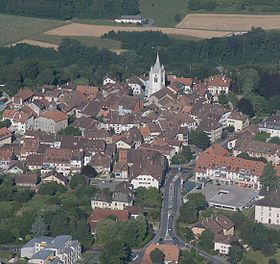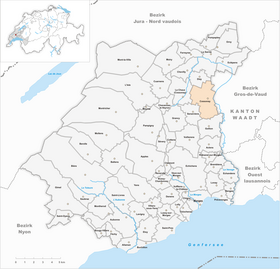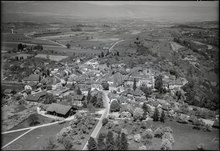Cossonay
| Cossonay | |
|---|---|
| State : |
|
| Canton : |
|
| District : | Morges |
| BFS no. : | 5477 |
| Postal code : | 1304 |
| Coordinates : | 528 801 / 162970 |
| Height : | 562 m above sea level M. |
| Height range : | 428–619 m above sea level M. |
| Area : | 8.28 km² |
| Residents: | 3876 (December 31, 2018) |
| Population density : | 468 inhabitants per km² |
| Website: | www.cossonay.ch |
|
Aerial view of Cossonay |
|
| Location of the municipality | |
Cossonay ([ kɔsɔnɛ ], in the native Franco-Provencal dialect [ (a) kɔsəˈne ]) is a municipality in the district of Morges in the canton of Vaud in Switzerland .
geography
Cossonay lies at 562 m above sea level. M. , 11 km north of the district capital Morges (linear distance). The town extends on the edge of the high plateau west of the Venoge , around 130 m above the river valley, in the Gros de Vaud , in the Vaud Central Plateau .
The 8.3 km² municipal area covers a section of the gently undulating plateau of the Gros de Vaud, the granary of the canton of Vaud. The largely canalised course of the Venoge forms the eastern border. From here, the municipality extends westward to the extensive plateau of Cossonay, extends in the south to the Valezard valley , in the north to the Pré Defour . The high plateau is bounded in the west by the Bois du Sépey forest , in which at 620 m above sea level. M. is the highest point of Cossonay. Here is also the protected pond Étang du Sépey , which was created through the renaturation of a former clay pit. In 1997, 13% of the municipal area was in settlements, 22% in forests and woodlands, 64% in agriculture and a little less than 1% was unproductive land.
Cossonay includes some single-family houses and the hamlet of Allens ( 543 m above sea level ) on the high plateau south of the village. The neighboring communities of Cossonay are Penthalaz in the southeast , Gollion in the south, Senarclen in the southwest , La Chaux (Cossonay) in the northwest , Dizy in the north and Lussery-Villars in the northeast .
population
With 3876 inhabitants (as of December 31, 2018), Cossonay is one of the medium-sized municipalities in the canton of Vaud. 89.1% of the residents are French-speaking, 3.1% German-speaking and 2.7% Portuguese-speaking (as of 2000). The population of Cossonay was 938 in 1850 and 1060 in 1900. In the course of the 20th century, the population increased slowly but continuously. Only since 1980 (1553 inhabitants) has a significantly increased population increase been observed.
economy
Until the 20th century, Cossonay was a town shaped by agriculture. Viticulture was practiced until the 15th century, and since then agriculture and livestock have dominated . Even today agriculture has a certain importance in the employment structure of the population.
Several mills had existed along the Venoge since the 16th century. With industrialization and transport links in the course of the 19th century, an industrial zone developed in the valley (for the most part in the municipality of Penthalaz), in which a condensed milk factory, a cable factory and a broom factory were located. Cossonay achieved a certain wealth as a result. At the beginning of the 20th century, Cossonay became the seat of one of the French-speaking sections of the Swiss Metal and Watch Workers Association. Important regional fairs and cattle markets were held in the town until 1920, but these were abandoned due to the establishment of the Comptoir Suisse in Lausanne. Another economic boom came in 1923 with the establishment of the Société des Câbleries et Tréfileries SA (today Alcatel Cable Suisse SA), which, however, is also located in Penthalaz.
Cossonay has a cinema that was set up in the former casino. It is a regional center with an industrial, commercial and administrative function. Mainly medium-sized and smaller companies are located in the town, specializing in electronics, scaffolding, transport, construction and wine trading. Cossonay has an archive of architecture and art history (managed by EPFL Lausanne) and is the location of the intercommunal school center Pré-aux-Moines (built 1982-89). The former district court was relocated to Nyon in 2000 .
In the past few decades, Cossonay has also developed into a residential community. Many workers are commuters who do their work in the greater Lausanne area.
traffic
The community has good transport connections. It is located at the intersection of the main road 9 from Lausanne to Vallorbe , the road from Morges to Orbe and the road over the Col du Mollendruz into the Vallée de Joux . The Cossonay motorway junction on the A1 (Lausanne-Yverdon) opened in 1981 is around 5 km from the town center.
On May 7, 1855, the Yverdon - Bussigny section of the Yverdon-Lausanne railway line with the Cossonay-Gare station in the Venogetal below Cossonay in the Penthalaz area was put into operation. The city was connected to the transport network in 1897 with the opening of the Cossonay Gare-Ville (CG) funicular . The Postbus courses from Cossonay-Gare to Cheseaux-sur-Lausanne and to L'Isle as well as from Cossonay-Ville on the one hand via Cottens and on the other hand via Aclens to Morges ensure the fine distribution in public transport . From the 2014/15 timetable change, the Cossonay station will be renamed Cossonay-Penthalaz.
history
The remains of a Roman manor and an early medieval burial ground were discovered in the municipality of Cossonay . The place was first mentioned in a document in 1096 under the name Cochoniacum . In 1164 the name Cosonai appeared and in 1228 Cossonai .
Ulrich von Cossonay donated the village church to the Romainmôtier monastery in 1096 . In 1224 it came into the possession of the Benedictines of Lutry , who had a priory built in Cossonay in the second half of the 13th century. The place was already fortified in the 11th century, in the 13th and 14th centuries the curtain walls were renewed and expanded. The town had been the seat of an important noble family since the High Middle Ages. The barons of Cossonay ruled an area from La Chaux (Cossonay) to Boussens and from Dizy to Gollion . In addition, numerous noble families were also under the rule of Cossonay.
The place was granted city rights around 1264. A fire at the end of the 14th century destroyed large parts of the town and the archive, so that the privileges had to be renewed in 1398 by the Baroness Johanna von Cossonay. When she died in 1406, the aristocratic seat became vacant and came to the House of Savoy by 1421 at the latest . This established the Savoyard Kastlanei Cossonay.
With the conquest of Vaud by Bern in 1536, the town came under the administration of the Bailiwick of Morges and continued to form a castleague. After the collapse of the Ancien Régime , Cossonay belonged to the canton of Léman from 1798 to 1803 during the Helvetic Republic, which then became part of the canton of Vaud when the mediation constitution came into force . In 1798 the district of Cossonay was created and the town was designated as its capital. Since 2008, Cossonay has been part of the Morges district.
Attractions
Cossonay has a picturesque medieval townscape with numerous town houses and patrician houses from the 17th to 19th centuries. No remains of the former city fortifications have survived, and the original castle of the Barons of Cossonay has completely disappeared.
The most important building in the historic town is the now reformed parish church of Saint-Pierre-et-Paul. It stands on the site of a church that was probably built in the 8th century. The current three-aisled construction goes back to the 13th century to a large extent. The striking church tower was built in the 15th century. The former priory buildings were converted into prisons and granaries during the Bernese period and later demolished. Parts of the priory were converted into the new Cossonay Castle, which was the seat of the local lords and now houses the prefecture.
In the old town are the Maison de Ville (town hall) from the 19th century with a classical facade, the Hôtel du Cerf from the 17th century and the late Gothic Café des Bains. The rectory dates from 1756.
photos
Web links
- Official website of the municipality of Cossonay (French)
- Paola Crivelli: Cossonay (municipality). In: Historical Lexicon of Switzerland .
- Aerial photography
- Château de Cossonay (French)
Individual evidence
- ↑ Permanent and non-permanent resident population by year, canton, district, municipality, population type and gender (permanent resident population). In: bfs. admin.ch . Federal Statistical Office (FSO), August 31, 2019, accessed on December 22, 2019 .
- ↑ Florence Cattin, Cossonay VD (Cossonay) in: Dictionnaire toponymique des communes suisses - Lexicon of Swiss community names - Dizionario toponomastico dei comuni svizzeri (DTS | LSG) , Center de dialectologie, Université de Neuchâtel, Verlag Huber, Frauenfeld / Stuttgart / Vienna 2005 , ISBN 3-7193-1308-5 and Éditions Payot, Lausanne 2005, ISBN 2-601-03336-3 , p. 267.









